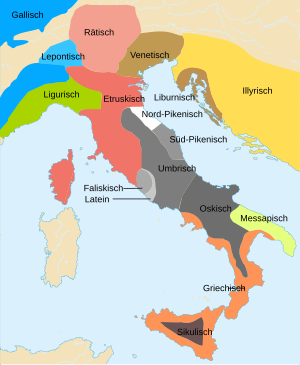Venetian language
| Venetic (†) | ||
|---|---|---|
| Period | until 1st century BC Chr. | |
|
Formerly spoken in |
Veneto , Friuli-Venezia Giulia | |
| Linguistic classification |
||
| Language codes | ||
| ISO 639 -1 |
- |
|
| ISO 639 -2 |
ine (other Indo-European languages) |
|
| ISO 639-3 |
xve |
|
In ancient times the Venetian language was mainly used by the Venetians in the hinterland of the northern Adriatic region .
The Venetian is passed down through approx. 400 inscriptions, mostly on stone and bronze objects as well as on clay and bronze vessels (situles) from the end of the 7th to the 1st century BC. It was written in several independent variants of the Etruscan alphabet - the most important are the Venetian alphabets of Este and Padua - and finally in the course of the Romanization also in the Latin alphabet. The distribution area of the inscriptions extends from eastern northern Italy between the rivers Po and Etsch (most important sites Este = Latin. Ateste with over 120 inscriptions, upper valley of the Piave ( Cadore ) with 66 inscriptions and Padova = Latin. Padua with 23 inscriptions) to Slovenia ( Istria , mainly river areas of the [Italian.] Isonzo and [sloven.] The Soca, but probably also on Helm B from Ženjak-Negau) and into the Gailtal in Carinthia / Austria. Most of them are short inscriptions on votive objects or in a funerary context. Only one inscription on a bronze plaque reworked into a leg brace, which has only been accessible since 1992, contains about 40 words, most of which have not yet been interpreted. Hans Kuhn brought up the Venetian as the language of a north-west block.
Linguists who have edited or evaluated Venetian inscriptions are among others. a. Giovan Battista Pellegrini , Aldo Luigi Prosdocimi , Michel Lejeune , Anna Marinetti , Franco Crevatin , Jürgen Untermann and Helmut Rix .
Whether the Venetian is an independent branch of the Indo-European language family or whether it is better to be combined with the Sabellian and Latino-Faliskian to form an “Italian” subfamily of Indo-European (according to Pierre Grimal ) is controversial.
The Venetian also shows some interesting parallels with the Germanic languages , e.g. B. in pronominal forms:
- venetic: ego , accusative mego
- Gothic: ik , mik
- German: I , myself
- (Latin: ego , me )
- venetian: sselboi sselboi
- Old high German: selb selbo
- German: oneself
- (Latin: sibi ipsi )
- (Pokorny 1959: 708-709, 882-884)
Attempts have also been made in the past to combine the Venetian with the Illyrian . However, this hypothesis has since been abandoned.
Text examples
Inscription on a bronze nail from Este (Es 45):
- venetian: mego donasto śainatei reitiiai porai egetora aimoi ke louderobos
- Latin (literally): me donavit sanatrici Reitiae bonae (??) Egetora pro Aemo que liberis
- German: Egetora donated me to the good (??) healing (??) Reitia for Aemus and the children
- (Prosdocimi and Pellegrini 1967: 149–150)
Inscription on a situla from Cadore (Ca 4 Valle):
- venetian: eik goltanos doto louderai kanei
- Latin (literally): hic Goltanus dedit Liberae Cani
- German: Goltanus donated this to the virgin Kanis
- (Prosdocimi in Pellegrini 1967: 464–468)
literature
- Michel Lejeune : Manuel de la langue vénète , Carl Winter - Universitätsverlag, Heidelberg 1974, ISBN 3-533-02353-2
- Mallory, Adams and Adams, Douglas Q .: Encyclopedia of Indo-European Culture , Routledge 1997, ISBN 1-884964-98-2
- JP Mallory: In Search of the Indo-Europeans . Thames and Hudson, London 1989 (repr. 1992), ISBN 0-500-27616-1
- Julius Pokorny: Indo-European Etymological Dictionary . Francke, Tübingen / Bern, 4th edition ISBN 3-7720-0947-6
- Giovanni Battista Pellegrini, Aldo Luigi Prosdocimi: La Lingua Venetica . I - Le iscrizioni, II - Studi. Padova 1967
- Jürgen Untermann: The Venetian personal names . Heidelberg 1961
- Jürgen Untermann: Veneti . In: Paulys Realencyclopädie der Classischen Altertumswwissenschaft , Supplement Volume XV, 1978, pp. 855-898
- Jürgen Untermann: The Venetian language. Report and reflection . In: Glotta , 58, 1980, pp. 281-317
- Helmut Rix: Germanic runes and Venetian phonetics . In: Comparative Germanic Philology and Scandinavian Studies (Festschr. Otmar Werner). Tübingen 1997, pp. 231-248
- Rex Wallace: Venetic . In: Roger D. Woodard (ed.): The Cambridge Encyclopedia of the World's Ancient Languages . University of Cambridge, 2004, ISBN 0-521-56256-2 , pp. 840-856
- Robert Nedoma: Veneter: general, historical, linguistic. In: Johannes Hoops: Reallexikon der Germanischen Altertumskunde . 2. completely new. and greatly expanded edition, ed. by Heinrich Beck et al. de Gruyter, Berlin / New York, Vol. XXXII (2006), pp. 133-134, 136-139
- Mariolina Gamba, Giovanna Gambacurta, Angela Ruta Serafini, Vincenzo Tiné, Francesca Veronese: [Venetkens.] Viaggo nella terra dei Veneti antichi , Padova 2013, ISBN 978-88-317-1559-1 (therein Marta Conventi: Bibliografia , p. 450 -462)
- Anna Marinetti: Il Venetico: La lingua, le iscrizioni, i contenuti . In: Mariolina Gamba, Giovanna Gambacurta, Angela Ruta Serafini, Vincenzo Tiné, Francesca Veronese: [Venetkens.] Viaggo nella terra dei Veneti antichi . Venezia, Marsilio, 2012, pp. 79-91
Web links
- Italian languages - literature. In: Encyclopædia Britannica .
- Rex Wallace: Venetic chapter. Encyclopedia of the World's Ancient Languages.
- Adolfo Zavaroni: Venetian Inscriptions (Italian).
- Indo-European database: The Venetic language ( Memento of February 2, 2009 in the Internet Archive ) Cyril Babaev (English).
- Venetic ( Memento of February 3, 2009 in the Internet Archive ) from the Voices of Stone website .
- Víteliú: the languages of ancient Italy (English)
Remarks
- ↑ Kathryn Lomas : The Veneti , in: Gary D. Farney, Guy Bradley (Ed.): The Peoples of Ancient Italy , Walter de Gruyter, 2017, pp. 701–717, here: p. 711.
- ↑ Untermann 1978
